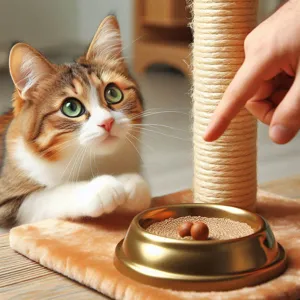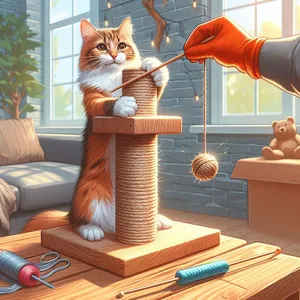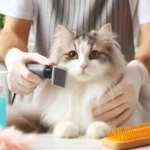Cats are notorious for their love of scratching, and while it’s a natural behavior, it can often lead to frustration for their owners when furniture and carpets fall victim to those sharp claws.
Fortunately, training your feline friend to use a scratching post is not only possible but can also be a rewarding experience for both you and your kitty. In this comprehensive guide, “Pawsitively perfect,” we will walk you through each step of the training process, from selecting the right type of scratching post to implementing positive reinforcement techniques that will entice your cat to make the switch. With a little patience and consistency, you’ll not only save your furniture but also provide your cat with a satisfying outlet for their scratching instincts. Get ready to transform your home into a scratching haven that both you and your cat will appreciate!
1. Understanding Your Cat’s Scratching Instincts

Understanding your cat’s scratching instincts is the first crucial step in training them to use a scratching post. Scratching is a natural and essential behavior for cats, serving multiple purposes that go beyond mere playfulness. It’s an instinct deeply rooted in their biology, acting as a way for them to keep their claws healthy and sharp. When cats scratch, they shed the outer layer of their claws, revealing the fresh, sharp claws underneath—much like a manicure for humans!
Moreover, scratching is a form of communication for cats. They have scent glands in their paws, and when they scratch, they leave behind both visual and olfactory marks. This marks their territory, signaling to other cats that this is their space. Understanding this instinct can help you appreciate why your feline friend might choose your favorite armchair over that brand-new scratching post you just bought.
Additionally, scratching serves as an excellent way for cats to stretch their muscles and relieve stress. After a long nap or a particularly thrilling bout of play, your cat might feel the urge to scratch as a way to rejuvenate and re-energize. By recognizing these instincts, you can better meet your cat’s needs and redirect their behavior toward appropriate scratching surfaces.
Creating an environment that respects and accommodates these natural impulses will go a long way in making the transition to a scratching post smoother. Choose a scratching post that is tall enough for a full stretch and sturdy enough to withstand their enthusiastic scratching. By understanding your cat’s scratching instincts, you equip yourself with the knowledge to guide them toward using their post instead of your furniture, ultimately fostering a harmonious living space for both you and your furry companion.
2. Choosing the Right Scratching Post
Choosing the right scratching post is crucial to ensuring your feline friend embraces this essential piece of furniture. Cats have unique preferences, and understanding these can make all the difference in their training and satisfaction. Start by considering the height of the scratching post. Cats love to stretch their bodies as they scratch, so a post that is tall enough for them to fully extend their limbs is ideal. Look for options that are at least two to three feet high, especially for larger breeds or particularly active cats.
Next, examine the material of the scratching post. Cats typically prefer either sisal rope or carpet for scratching. Sisal is durable and provides a satisfying texture for cats to dig their claws into, while carpet can be appealing for those who enjoy a softer surface. Some cats may even prefer cardboard or wood, so it might be worth experimenting with a few different types to see what your cat gravitates toward.
Stability is another key factor. A scratching post should be sturdy enough to withstand vigorous scratching without toppling over. If the post wobbles or falls, your cat may become discouraged and seek out less appropriate surfaces for their scratching needs. A solid base will give your cat the confidence to scratch freely and happily.
Finally, consider the design and aesthetics of the scratching post. While functionality is essential, you also want to choose a post that complements your home decor. With a wide variety of styles available—from sleek modern designs to rustic wooden options—you’re sure to find a scratching post that fits both your cat’s needs and your home’s aesthetic.
By carefully selecting a scratching post that meets these criteria, you’ll set the stage for successful training and encourage your cat to use their designated scratching area rather than your furniture or carpets. And remember, patience is key; it may take some time for your cat to adjust to their new scratching post, but with the right choice, you’ll be well on your way to a pawsitively perfect scratching routine!
3. Preparing Your Home for Scratching Success

Creating an environment that encourages your cat to embrace the scratching post is crucial for successful training. Start by strategically placing the scratching post in areas where your cat loves to spend time. Cats naturally gravitate towards places they feel comfortable and secure, so observe their favorite lounging spots and position the post nearby. This proximity increases the likelihood that your cat will investigate and use the post regularly.
Consider the type of scratching post you choose as well. Cats have different preferences—some may prefer vertical surfaces for a good stretch, while others might favor horizontal ones for a more relaxed scratch. Invest in a variety that caters to these preferences, and don’t shy away from experimenting with different materials like sisal, cardboard, and carpet. Each texture offers a unique scratching experience that can appeal to your feline friend.
To further entice your cat, enhance the scratching post with a sprinkle of catnip or a few enticing toys. This aromatic herb is a natural attractant for many cats and can create a sense of curiosity and excitement around the post. You might also consider using treats to reward your cat for using the scratching post, reinforcing positive behavior and making the experience more enjoyable.
Lastly, keep your home clutter-free and ensure that the scratching post stands out as a distinct option among your cat’s playthings. If your furniture or carpets are already bearing the brunt of your cat’s scratching tendencies, be proactive by covering those areas with protective mats or double-sided tape until your cat learns to redirect their scratching behavior. By thoughtfully preparing your home for scratching success, you’ll create an inviting space that encourages your cat to engage with their post, helping to save your furniture and fostering healthy habits along the way.
4. Introducing the Scratching Post to Your Cat
Introducing the scratching post to your cat is a crucial step in ensuring they embrace it as their go-to outlet for scratching. Cats are naturally inclined to scratch, as it helps them keep their claws healthy, mark their territory, and stretch their muscles. However, if they don’t immediately recognize the scratching post as a suitable option, they may resort to your furniture or carpets instead.
Start by placing the scratching post in a location where your cat spends a lot of time, ideally near their favorite resting spots or close to the furniture they usually scratch. This makes it more likely for them to notice and investigate the new addition. To pique their curiosity, consider sprinkling a little catnip on or around the post. The enticing aroma can be irresistible and may encourage your cat to explore and engage with it.
Observe your cat’s reactions. If they show interest, you might even want to gently guide their paws to the post, mimicking the motion they would use while scratching. This hands-on approach can help them associate the scratching post with a positive experience. Additionally, if your cat begins to scratch the post, offer plenty of praise, treats, or affection to reinforce the behavior.
If your cat seems hesitant or indifferent, don’t fret. It may take time for them to warm up to their new scratching post. Patience is key. You can also try different types of scratching posts—some cats prefer vertical posts, while others like horizontal surfaces. By experimenting with various materials and styles, you’ll find the perfect fit for your feline friend. With a little time and encouragement, your cat will likely come to see the scratching post not just as a tool, but as an essential part of their territory and daily routine.
5. Creating a Positive Association with the Scratching Post

Creating a positive association with the scratching post is a pivotal step in ensuring your cat embraces this new addition to your home. Cats are naturally inclined to scratch, not just for their physical health but also as a form of communication and stress relief. By transforming the scratching post into a desirable destination, you can effectively guide your feline friend to use it instead of your beloved furniture.
Start by placing the scratching post in a location where your cat already enjoys spending time. This could be near their favorite sunny spot by the window or close to where they often play. Familiarity is key; your cat is more likely to explore and use the scratching post if it’s in a comfortable environment.
Next, enhance the appeal of the scratching post with enticing elements. Consider sprinkling a bit of catnip on or around the post. This aromatic herb can stimulate your cat’s senses and create an irresistible attraction. You can also dangle a few of their favorite toys from the top of the post, encouraging them to play and scratch simultaneously. The goal is to make the scratching post a fun and engaging space, so they associate it with positive experiences.
As your cat begins to show interest, reward them with praise or treats when they use the scratching post. This positive reinforcement helps to build a strong connection between the action of scratching and the joy of receiving attention or a tasty reward. Consistency is crucial here; be sure to celebrate every small victory, whether it’s a gentle pawing or a full-bodied scratch.
Lastly, be patient. It might take some time for your cat to fully embrace the scratching post, especially if they have been accustomed to scratching other surfaces. Avoid scolding or punishing them for not using it; instead, redirect their attention with toys or playtime if you catch them scratching an inappropriate surface. Over time, with your encouragement and the right positive associations, your cat will likely come to view the scratching post as their designated scratching haven, helping to protect your furniture and keep your feline friend happy and healthy.
6. Using Catnip and Toys to Encourage Usage
Using catnip and toys to encourage usage of the scratching post can be a game changer in your training routine. Cats are naturally curious and playful creatures, and incorporating enticing elements like catnip can make the scratching post an irresistible attraction.
Start by sprinkling a generous amount of catnip on the surface of the scratching post. This aromatic herb is known for its stimulating effect on many felines, often eliciting playful antics or a blissful calm. Watch as your cat approaches the post, drawn in by the tantalizing scent. This initial introduction can spark their interest and increase the likelihood of them using the post instead of your furniture or carpets.
In addition to catnip, utilizing toys can further enhance the appeal of the scratching post. Dangle a feather toy or a string from the top of the post, allowing your cat to pounce and bat at it while also engaging with the post itself. This not only encourages them to scratch but also provides a fun and interactive playtime experience. You can even attach a ball or a small plush toy to the post, making it a dual-purpose structure for scratching and play.
Consistency is key—engage your cat regularly with these enticing elements. Create a routine where playtime revolves around the scratching post, reinforcing its importance in their environment. Over time, your cat will associate the post with positive experiences, leading to a natural inclination to use it.
Remember to be patient and give your feline friend time to adjust. With a little creativity and encouragement, you’ll transform your scratching post into an appealing playground, ensuring your cat scratches in style while keeping your home fur-free and furniture intact!
7. Training Techniques: Steps to Get Your Cat to Scratch

Training your cat to use a scratching post can be a rewarding experience for both you and your feline friend. However, it requires patience, consistency, and a bit of creativity. Here are some effective techniques to encourage your cat to embrace their new scratching post.
**1. Choose the Right Scratching Post:** Start by selecting a scratching post that appeals to your cat’s preferences. Cats typically enjoy posts that are tall, sturdy, and covered in materials like sisal or carpet. Observe your cat’s current scratching habits—do they prefer horizontal or vertical surfaces? This insight will help you make the best choice.
**2. Placement is Key:** Position the scratching post in a location where your cat already likes to scratch. Cats often scratch after waking up or when they’re feeling playful, so placing the post near their favorite resting spot or play area can significantly increase the likelihood of them using it.
**3. Use Attractants:** To entice your cat to the scratching post, consider using catnip or feline pheromone sprays. Gently rubbing the post with catnip can pique their interest and encourage them to explore. You might also try playing with your cat near the post, using toys to draw them closer and create positive associations.
**4. Demonstrate Scratching:** Sometimes, your cat may need a little guidance. Gently scratch the post with your own hands or use a toy to interact with it, showcasing how to use it. Cats are naturally curious, and seeing you engage with the post can spark their interest.
**5. Reward and Reinforce:** Positive reinforcement is crucial in training. When your cat uses the scratching post, immediately offer praise or a small treat. This association between scratching the post and receiving rewards will encourage them to repeat the behavior.
**6. Redirect Unwanted Scratching:** If your cat begins scratching furniture or other inappropriate surfaces, gently redirect them to the scratching post. Use a firm but calm voice to say “no” and guide them to the post. Consistency is vital here—every time you catch them in the act, gently redirect them without scaring or punishing them.
**7. Be Patient:** Remember that training takes time. Some cats may take to the scratching post instantly, while others might need a bit longer to adjust. Keep the environment positive, and don’t get discouraged if progress is slow. With persistence and encouragement, your cat will soon scratch happily on their designated post, saving your furniture and ensuring they have an outlet for their natural instincts.
By employing these techniques and remaining patient, you’ll create a harmonious environment where your cat can satisfy their scratching urges while keeping your home intact. Happy training!
8. Redirecting Unwanted Scratching Behavior
Redirecting unwanted scratching behavior is a crucial aspect of training your cat to embrace the scratching post while keeping your furniture and belongings safe from those sharp claws. Cats have a natural instinct to scratch; it helps them stretch their muscles, mark their territory, and maintain their claws. Therefore, understanding this instinct is key to effective training.
Start by observing your cat’s favorite scratching spots. If it’s your sofa or a cozy rug, you can strategically place the scratching post nearby. This proximity makes it easier for your feline friend to transition from the forbidden zones to their designated scratching haven. Use enticing materials like sisal or cardboard for the scratching post, as these textures are often more appealing to cats.
To further encourage your cat to use the scratching post, you can sprinkle catnip on it or use catnip-infused toys to create a positive association. Cats are naturally drawn to catnip, and this scent can entice them to investigate the new post. When you catch your cat scratching the post, praise them enthusiastically or offer a small treat, reinforcing this positive behavior.
If your cat continues to scratch unwanted surfaces, consider using double-sided tape or a spray deterrent on those areas. Cats dislike the sticky texture and will soon learn to avoid scratching there. Additionally, be patient and consistent. Training takes time, and with persistence, your cat will learn that the scratching post is their go-to spot for satisfying their scratching needs.
Remember, every cat is unique, so tailor your approach to suit your pet’s personality. With a little creativity and lots of encouragement, you’ll create an environment where both your cat and your furniture can coexist happily!
9. Maintaining the Scratching Post: Care and Upkeep
Maintaining your cat’s scratching post is essential for ensuring it remains an enticing and functional part of your feline friend’s environment. Regular care not only prolongs the life of the post but also encourages your cat to continue using it instead of your furniture or walls.
Start by inspecting the scratching post weekly for any signs of wear and tear. Look for frayed edges or loose sisal rope, as these can deter your cat from using it. If you notice any damage, consider repairing it promptly; a little bit of glue can go a long way in sticking down any loose materials, and a quick trim of frayed bits can refresh the post’s appearance.
Cleaning is another critical aspect of upkeep. Cats have a knack for leaving behind fur and dander, which can accumulate over time. A simple vacuuming every few weeks can help remove hair and dirt, making the post more appealing. For deeper cleaning, wipe down wooden or plastic parts with a damp cloth, and use a pet-safe cleaner to disinfect the fabric or sisal areas.
Additionally, consider your cat’s preferences when it comes to the scratching post’s location. If you notice your cat is scratching elsewhere, it might be time to reposition the post to a more prominent spot, perhaps near their favorite resting area or in a room where they spend most of their time.
Lastly, don’t forget to keep the scratching post interesting! Cats can get bored easily, so occasionally sprinkle catnip on the post or attach new toys that dangle from it. This small change can reinvigorate your cat’s interest and keep them coming back for more. By committing to regular maintenance and updates, you’ll not only extend the life of your scratching post but also create a welcoming environment for your cat to stretch, scratch, and satisfy their natural instincts.
10. Reinforcing Good Habits with Rewards
Reinforcing good habits with rewards is an essential component of successfully training your cat to use a scratching post. Cats, like many animals, respond positively to rewards, which can significantly enhance their learning experience and encourage the behaviors you want to cultivate.
Start by selecting a reward that your cat finds irresistible. This could be their favorite treat, a small piece of cooked chicken, or even a bit of catnip. The key is to ensure that the reward is something your cat truly enjoys, as this will motivate them to engage with the scratching post.
When your cat uses the scratching post correctly, immediately offer the reward. Timing is critical here; the praise and treat should be given right after they scratch the post to create a clear connection between the action and the positive reinforcement. You might say a cheerful “Good job!” or “Yes!” in a high-pitched voice to convey your excitement. This not only reinforces the behavior but also builds a bond between you and your feline friend.
Consistency is vital. Make sure to reward your cat every time they use the scratching post correctly, especially in the initial training stages. As they begin to understand that scratching the post leads to a treat, you can gradually decrease the frequency of rewards, eventually transitioning to a more intermittent reinforcement schedule. This method keeps your cat motivated and engaged, as they will continue to seek out the scratching post in hopes of receiving a reward.
Additionally, consider incorporating playtime as a reward. Engaging your cat in a fun game with a feather wand or laser pointer after they use the scratching post can also help reinforce the behavior. This approach not only encourages scratching in the right place but also enriches their environment, making the training process enjoyable for both of you.
Remember, patience is key. Training your cat to use a scratching post may take time, but with consistent rewards and positive reinforcement, you’ll be well on your way to a pawsitively perfect scratching routine!
11. Troubleshooting Common Training Challenges
Training your cat to use a scratching post can be a rewarding experience, but it doesn’t come without its challenges. If you find yourself facing some roadblocks along the way, don’t fret! Here are some common training challenges and effective strategies to overcome them.
**1. Reluctance to Use the Scratching Post:**
If your cat seems completely uninterested in the scratching post, consider its location. Cats are instinctively drawn to areas where they feel secure. Placing the post near their favorite resting spot or by a window where they can watch the world outside can entice them to give it a try. Moreover, the texture of the post matters! Ensure you’re using a material that appeals to your cat—some cats prefer carpet, while others might favor sisal or cardboard.
**2. Preference for Furniture:**
If your feline friend is still opting for the couch or your favorite chair instead of the scratching post, it may be time to reevaluate the post’s appeal. Try rubbing a little catnip on the post to make it more enticing. Additionally, you might want to create a “no-scratch zone” around your furniture by using double-sided tape or specialized furniture protectors. This helps communicate to your cat that the scratching post is the designated scratching area.
**3. Over-scratching:**
Sometimes, a cat can become overly enthusiastic about scratching, leading to damage to the scratching post or surrounding furniture. To mitigate this, monitor your cat’s scratching habits and encourage breaks. You can also provide multiple scratching surfaces to redirect their energy. If your cat is particularly vigorous, consider investing in a more robust scratching post designed to withstand heavy use.
**4. Stress-related Scratching:**
If your cat is scratching excessively, it may be a sign of stress or anxiety. Changes in the environment, such as moving to a new home or the introduction of new pets, can trigger this behavior. Create a calm and stable environment by providing plenty of hiding spots and vertical spaces for your cat to retreat to. Consider using calming pheromone diffusers or sprays to help reduce anxiety levels.
**5. Patience is Key:**
Lastly, remember that every cat is unique. Some may take to the scratching post immediately, while others require more time and encouragement. Be patient and consistent with your training efforts. Celebrate small victories, and don’t hesitate to adjust your approach as you learn more about your cat’s preferences and behaviors.
By troubleshooting these common challenges with care and creativity, you can foster a positive training experience that benefits both you and your feline companion. With persistence and understanding, your cat will soon be happily scratching away at their designated post, keeping your furniture safe and their claws healthy!
12. Why Scratching Posts Are Essential for Cat Health
When it comes to feline well-being, scratching posts are not just a luxury; they are an essential component of a cat’s physical and mental health. Cats have an innate instinct to scratch, and providing them with a designated area to do so is crucial for several reasons.
Firstly, scratching is a natural behavior that allows cats to maintain their claws. The action of scratching helps to remove the outer sheath of their claws, revealing the sharp, healthy claws underneath. This is particularly important for indoor cats, who may not have the opportunity to naturally wear down their claws through outdoor activities. Regular claw maintenance prevents overgrowth and reduces the risk of painful snagging or injury.
Moreover, scratching serves as an important form of exercise. Cats are natural hunters, and their bodies are designed for movement and play. Engaging with a scratching post encourages your feline friend to stretch, jump, and engage their muscles, promoting physical fitness. This is especially vital for indoor cats, who may not get enough exercise without the stimulation of the great outdoors.
In addition to physical benefits, scratching is also a way for cats to mark their territory. Cats have scent glands in their paws, and when they scratch, they leave behind their scent, signaling to other animals that this is their space. Providing a scratching post offers your cat an outlet for this instinctual behavior, reducing the likelihood of them scratching furniture or other household items in an attempt to establish their territory.
Lastly, scratching can be a significant stress-reliever for cats. Just like humans may unwind with a good stretch or a bit of physical activity, scratching allows cats to release pent-up energy and anxiety. By giving your cat an appropriate outlet for scratching, you can help prevent behavioral issues that stem from stress or frustration.
In summary, scratching posts are essential for cat health as they promote claw maintenance, provide exercise, help establish territory, and alleviate stress. By investing in a high-quality scratching post and encouraging its use, you’re not only protecting your furniture but also ensuring your furry companion leads a happy, healthy life.
13. Alternative Options: Other Types of Scratching Surfaces
While traditional scratching posts are a staple in feline training, it’s essential to recognize that cats can be quite particular about their scratching preferences. To keep your furry friend engaged and satisfied, consider introducing a variety of alternative scratching surfaces. These options not only add excitement to your cat’s environment but also cater to their natural instincts.
**1. Scratching Pads:** These flat surfaces, often made from cardboard or sisal, can be placed on the floor or mounted on walls. Their design encourages cats to stretch and scratch at different angles, providing a delightful change of pace from a standard post.
**2. Scratching Loungers:** Combining a scratching surface with a cozy place to lounge, these loungers cater to your cat’s desire to scratch while also giving them a comfortable spot to relax. Look for loungers made from durable materials that can withstand enthusiastic scratching.
**3. Climbing Trees with Built-in Scratching Areas:** Cat trees are not just for climbing; many come with integrated scratching surfaces. These multifunctional structures provide your cat with a playground while satisfying their scratching needs, making them an excellent addition to any feline-friendly home.
**4. Wall-Mounted Scratching Boards:** For a space-saving solution, consider wall-mounted scratching boards. These can be installed at various heights, allowing your cat to scratch while standing or stretching. Plus, they offer a unique way to incorporate scratching surfaces into your home decor.
**5. Natural Elements:** If you have the space, consider introducing natural scratching elements such as tree branches or logs. Cats are drawn to the texture and scent of wood, making these a delightful alternative that connects them with their wild instincts.
By diversifying the scratching surfaces available to your cat, you’re not only preventing potential destruction of your furniture but also enriching their environment. Experiment with different options to discover which surfaces your cat loves the most, ensuring that their scratching habits remain both positive and productive. Remember, a happy cat is a well-scratched cat!
14. The Benefits of Creating a Scratching Routine
Creating a scratching routine for your cat is not just a matter of keeping your furniture safe; it’s an essential aspect of feline well-being that can lead to a happier and healthier pet. Cats are instinctive scratchers, and establishing a routine around this natural behavior can provide numerous benefits for both you and your furry friend.
First and foremost, a scratching routine helps satisfy your cat’s innate scratching instincts. By encouraging them to scratch at designated posts rather than your couch or curtains, you’re allowing them to stretch their muscles, sharpen their claws, and mark their territory in a way that’s both satisfying and safe. Cats have scent glands in their paws, and scratching is a way for them to communicate their presence to other felines. By having a dedicated scratching routine, you create a designated space for these behaviors, which can help reduce stress and anxiety.
Additionally, regular scratching can aid in your cat’s physical health. It promotes good claw health by removing the outer sheath of the claw, which can help prevent overgrowth and related issues. A well-scratched post can also contribute to the overall fitness of your cat, as the act of stretching and scratching can improve flexibility and muscle tone.
To create a successful scratching routine, designate specific times in the day when you engage with your cat at the scratching post. This could be part of your daily playtime or a calming evening ritual. Encourage your cat to scratch by using treats or interactive toys near the post, reinforcing the behavior with positive reinforcement. Over time, your cat will associate the scratching post with fun and reward, making it their preferred outlet for those instinctive scratching urges.
Moreover, a well-established scratching routine can enhance your bond with your cat. Engaging in this activity together allows for quality time spent, fostering trust and understanding. You’ll not only be protecting your belongings but also creating a nurturing environment that respects your cat’s natural behaviors. A little consistency goes a long way in ensuring that your feline friend enjoys their scratching routine, leading to a more harmonious home for both of you.
15. Final Thoughts: Patience and Consistency in Training
As we reach the conclusion of this comprehensive guide, it’s essential to underscore a cornerstone principle of cat training: patience and consistency. Training your feline friend to embrace the scratching post is not merely a task to be checked off your list; it’s a journey that requires dedication and understanding of your cat’s unique personality and instincts.
Cats are creatures of habit, and they thrive within a stable environment. This means that the more consistent you are with your training methods, the more effectively your cat will learn to associate the scratching post with positive experiences. Establish a routine that incorporates regular interactions with the post, ensuring it’s always accessible and enticing.
Remember, every cat learns at its own pace. Some may take to the scratching post immediately, while others might need a bit longer to warm up to the idea. Celebrate the small victories along the way, whether it’s a curious sniff, a tentative paw swipe, or an enthusiastic scratch. Each positive interaction reinforces the behavior you want to encourage.
Moreover, maintaining a calm demeanor during training is crucial. Frustration can easily transfer to your cat, making them anxious or resistant. Instead, approach each training session with a sense of playfulness and encouragement. Use treats, praise, and gentle guidance to create an inviting atmosphere that fosters learning.
In conclusion, transforming your cat into a dedicated scratching post user is a rewarding endeavor that enhances both your home environment and your pet’s well-being. With patience, consistency, and a sprinkle of creativity, you can cultivate a positive scratching habit that keeps your furniture safe and your cat happy. Embrace the process, and enjoy the bonding moments that arise as you both navigate this journey together. Happy training!
In conclusion, training your cat to use a scratching post can transform both your feline’s behavior and your home environment, turning potential chaos into a harmonious coexistence. By following the step-by-step guide outlined in this post, you can create a positive and rewarding experience for both you and your cat. Remember, patience and consistency are your best allies in this journey. Celebrate the small victories along the way, and soon you’ll witness your furry friend happily honing their scratching skills on the designated post. With a little effort and understanding, you’ll foster a loving bond while ensuring your furniture stays safe and sound. Happy scratching!






